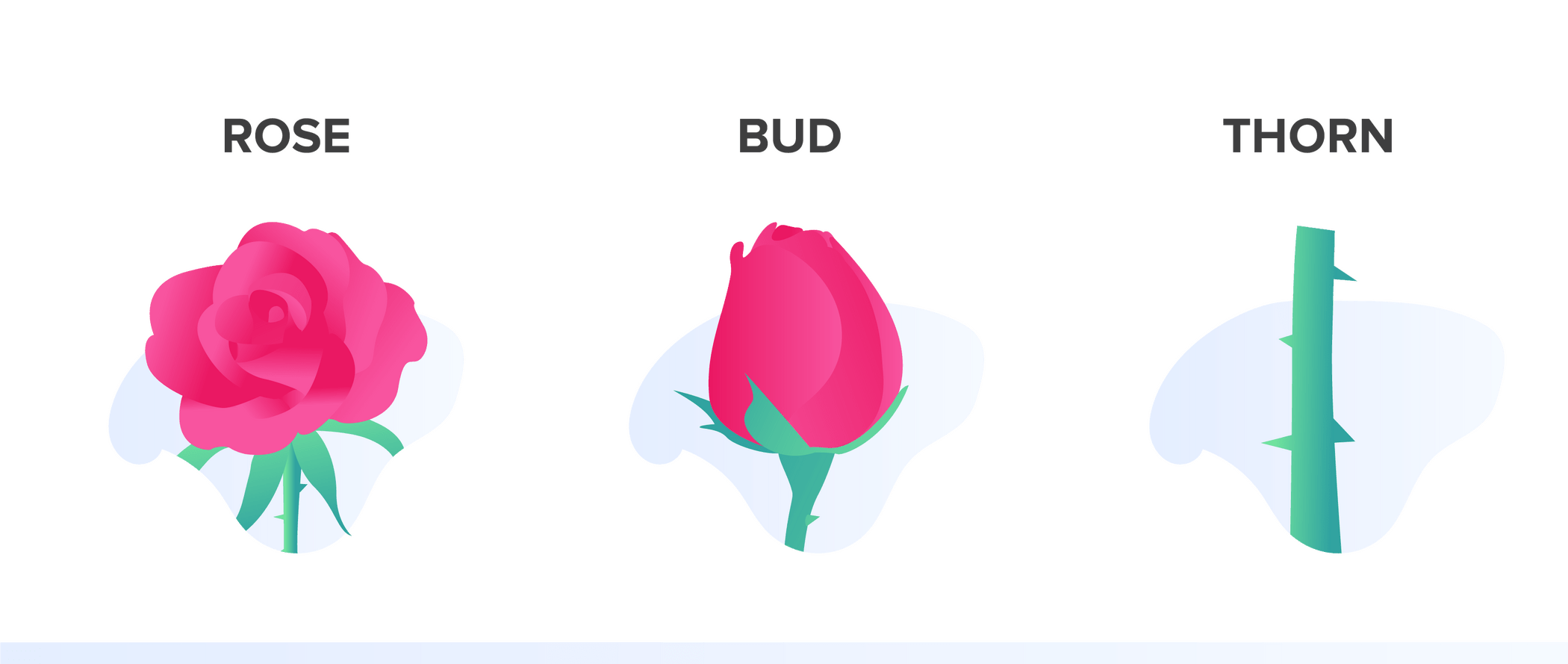Rose, Bud, Thorn - Design Thinking Exercise
Ever feel you’re too close to a project to see what’s working, what’s not working, and where to take your next steps?
It happens to every team at some point. But this “can’t see the wood for the trees” paradox is easily solved, with a Design Thinking activity called Rose, Bud, Thorn.

What is the Rose, Bud, Thorn Design Thinking exercise?
The Rose, Bud, Thorn exercise is a simple activity that anyone can do at any time.
It's as popular in business as it is in schools, mindfulness classes, and when debriefing with friends after a first date. The idea is to evaluate a project, event, or even your day by highlighting a Rose, Bud, and Thorn.
- Rose: The Rose is the positive highlight. If reviewing your day, maybe your Rose is the pancakes you had for breakfast, or if reviewing a project, maybe it was the positive feedback you received from the client.
- Bud: The Bud is an opportunity for improvement — an idea you had, or something you're looking forward to. It's a potential Rose. This might be your morning workout tomorrow or an upcoming project you're excited to start.
- Thorn: Thorns are something that most of us are pretty good at spotting. It's anything that didn't go the way you hoped it would. Maybe you dropped your first pancake when trying to flip it, or maybe there was an aspect of your project that you weren't able to fully realize.
How Rose, Bud, Thorn works
Though you can use the Rose, Bud, Thorn in many ways, we’re going to focus on using it at work — for problem solving in particular. In this setting, you'll find that coming up with multiple Roses, Buds, and Thorns is more helpful than just choosing one.
If you're by yourself, you might choose a number of each to write down. If you're part of a group, you might have each member of the team come up with one Rose, Bud, and Thorn each. If needed, you can come up with prompt questions to help get the creative juices going (we've listed a few examples further down).
After you have all of these written down, either on a whiteboard or on sticky notes across your conference room wall, take time to talk through each point with your team.
Celebrate and appreciate your Roses, come up with ways to maximize on Buds, and create solutions for removing Thorns.
What's the purpose of the Rose, Bud, Thorn exercise?
The purpose of Rose, Bud, Thorn is to:
- Acknowledge strengths and weaknesses — putting measures in place to do more of what’s going well, and fix what needs fixing.
- Inspire ideation and debate within teams — discussing Buds can encourage new, innovative ideas to come to the fore.
- Gaining insight from all members of the team — even those who would usually shy away from giving their input.
Who should use Rose, Bud, Thorn (and who should you involve)?
Rose, Bud, Thorn is useful for a variety of groups, including project managers, designers, developers, and a vast variety of other teams.
Any time you are involved in a collaborative effort with others, the Rose, Bud, Thorn exercise will prove useful. When possible, it's best to include everyone who is working towards your team's success, as this will provide the most holistic results.
Example questions for the Rose, Bud, Thorn exercise
If you're new to Rose, Bud, Thorn, you may find it takes some time for the activity to flow naturally. Or if you're on a team, you may notice that certain members have a hard time coming up with their own Roses, Buds, and Thorns.
To help, we've listed out a few example questions to ease the process.
Rose
1. What are you most proud of?
This question is the essence of the Rose — focusing on the bright side and boosting your team's morale. Starting the activity by asking for everyone's Rose will get things off on a good note.
2. What was the highlight of the project/day/event?
In situations where you'd rather focus on events rather than goals, you can use this question. It's a great way to point out bright spots that you might not have foreseen or had control over.
Bud
1. What are you most looking forward to?
Again, this captures the essence of the Bud — forward-looking optimism.
2. What can we improve?
If you're still in the middle of an ongoing process or project, this question will help bring fresh ideas to the surface, reinvigorating your team.
Thorn
1. What caused you the most stress?
The Thorn part is, by nature, the least pleasant to discuss. Starting with this question will help team members vent their stress rather than focusing on their failures.
2. What do you wish would have turned out better?
It's important to remember with this question — and with any other Thorns — that the goal is to be as constructive as possible. Try to avoid pointing out problems that can't be improved.
